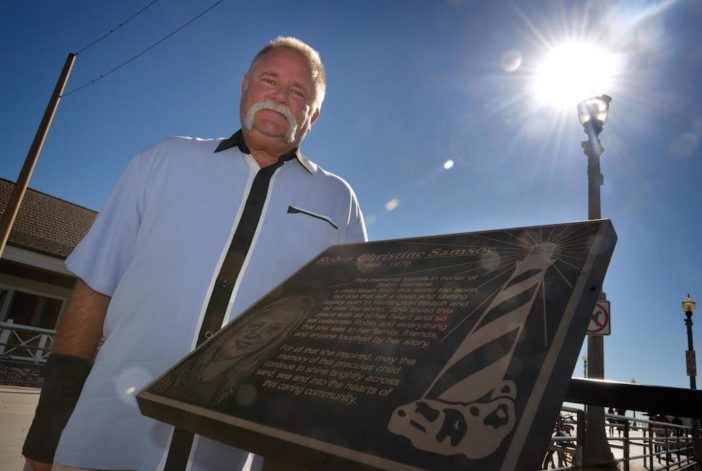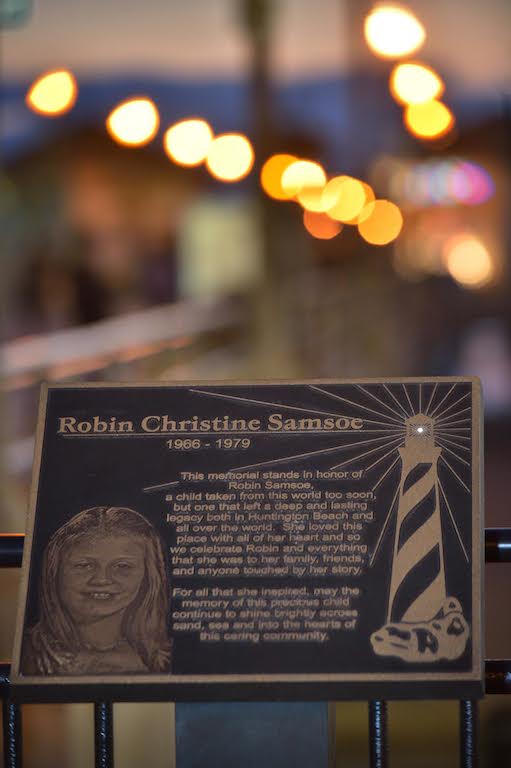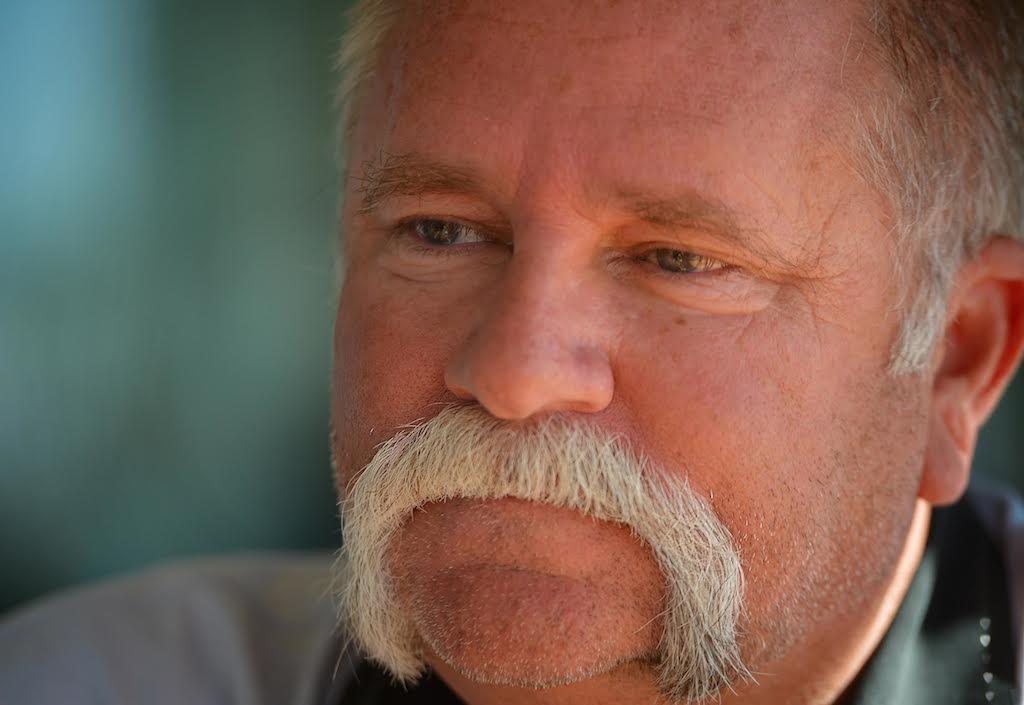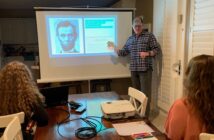Editor’s note: In honor of Behind the Badge OC’s one-year anniversary, we will be sharing the 30 most-read stories. This story originally published Nov. 25, 2014.
Every day, Steve Mack passes a street sign hanging in his garage that bears the name of a serial killer.
In 2004, that sign almost was posted on a Huntington Beach street in a condominium development, but Mack successfully campaigned to have it taken down.
No street in Huntington Beach should share the same name as the man who kidnapped and killed 12-year-old Robin Samsoe.
“I don’t know why I keep it,” Mack said.
Some days he looks up at the sign that reads “Alcala.” On other days, he ignores it.
The sign sits in his garage as a reminder of the case that consumed much of his world for five years.
Mack was the Huntington Beach detective that helped keep serial killer Rodney Alcala in jail after Alcala’s murder conviction was overturned twice.
The California Supreme Court overturned the murder conviction in 1984 and the U.S. 9th Circuit Court of Appeals reversed the decision in 2001 — both on technicalities.
Mack got the case in 2003 and helped obtain a third conviction for “that murderous piece of scum.”
Mack won’t say his name.
“He doesn’t need the recognition,” he said. “I’ve said his name enough over the years.
“The person who needs to be remembered in all of this is Robin.”
And Samsoe will be remembered not only by her family, friends and Mack, but also by anyone who visits the Huntington Beach pier.
The city in October unveiled a memorial plaque that tells Samsoe’s story to forever honor the little girl whose disappearance and brutal murder shook a community to its core.
“It was the first time in Huntington Beach that anything like this happened,” Mack said. “It was unbelievable that a 12-year-old could be snatched off the streets in the middle of the day in Surf City.”
CATCHING A KILLER
For weeks after June 20, 1979, alleyways and dark places behind commercial shopping centers were the safest places in Huntington Beach, Mack said.
Mack remembers being a patrol officer and scouring hidden areas for the yellow Schwinn the young ballerina was riding when she disappeared.
On June 20, 1979, Samsoe was riding that bicycle to dance class, but she never arrived.
Twelve days later, her body was found in the foothills of the Sierra Madres.
Alcala was arrested on July 24, 1979 and later convicted of the kidnap and murder of Samsoe.
While investigating Samsoe’s murder, detectives found a storage locker filled with hundreds of photographs of women.
Investigators deduced the photos were either mementos from his kills or a catalog of potential victims.
A pair of gold ball earrings and a pair of tiny rose earrings also were found in that locker.
They knew Samsoe likely was one of Alcala’s many victims.
Detectives learned the gold ball earrings belonged to Samsoe, which helped build the case against Alcala.
“The detectives in 1979 deserve all the credit because they did an exceptional job,” Mack said. “They left no stone unturned.”
Still, the conviction was twice reversed and investigators were left combing through evidence, testimony and interviews to make sure Alcala stayed where he belonged — on San Quentin’s death row.
By 2003, forensic science gave investigators an advantage their predecessors didn’t have.
“Nobody had even heard of DNA in 1979,” he said. “That busted the case wide open.”
RELIVING THE CASE
Mack pored over Samsoe’s case for five years.
“I asked for the case because I was here in 1979 when this happened so it was personal,” he said.
He read thousands of pages about Samsoe’s life, her family and her brutal murder.
He delved so deep she came to life on the page.
“I swear sometimes I could see her dancing and I could almost hear her laugh,” he said.
Mack obtained court orders for all the evidence in the case to be released and ran DNA tests on Alcala’s car and a shoe and towel found near Samsoe’s body.
Nothing came up.
Also in the pile of evidence: a small red satin pouch that held two rose earrings.
He tested them and got a hit.
But it wasn’t what Mack expected.
“The DNA on those earrings belonged to Charlotte Lamb,” he said. “And it was in our evidence locker.”
Lamb was a 32-year-old legal secretary who was found murdered in the laundry room of an El Segundo apartment complex in 1978.
The DNA on the earrings was the second time in 2003 that Alcala was linked to her murder.
Also that year, Los Angeles prosecutors took a swab of Alcala’s mouth while he was in prison. The results linked the amateur photographer with two murders: Lamb and Georgia Wixted, 27, who was raped and killed in her Malibu home in 1977.
DNA evidence also linked Alcala to two other Los Angeles County slayings: the torture and murder of 18-year-old Jill Barcomb in 1977 and the killing of Jill Parenteau, 21, in Burbank.
“It was that earring that allowed us to try that case as a joint murder rather than separating the case as Los Angeles County and Orange County,” Mack said.
FINAL CONVICTION
Alcala represented himself in the third trial on Samsoe’s murder in a bold display of his arrogance or perhaps his delusion, Mack said.
Mack silently fumed as he watched the twice-convicted killer cross-examine Samsoe’s mother.
Alcala asked personal questions. He stood too close. He looked straight in her face.
“Emotionally it was hard for me to sit there and watch that,” he said. “It was infuriating.”
Mack kept his composure with his thoughts on the end game — keeping Alcala locked up.
“All the evidence they needed for conviction they’ve had since 1979,” he said. “He couldn’t overcome it and he had no explanation for it.”
Alcala was convicted in February 2010 for killing Samsoe and the rape, torture and murder of the four Los Angeles women.
The case was over.
But for Mack, it is never forgotten.
In addition to the Alcala street sign in Mack’s garage, he keeps a board used by prosecutors during the trial that has the photos of the five women pasted above a photo of Alcala.
“I keep it in memory of this case and in memory of the victims,” he said. “Even today, after retirement, Robin and her family are on my mind.
“I am waiting for the day that Mother Nature does what the courts refuse and we can all move on.”
Photos by Steven Georges/Behind the Badge OC
 Behind the Badge
Behind the Badge





